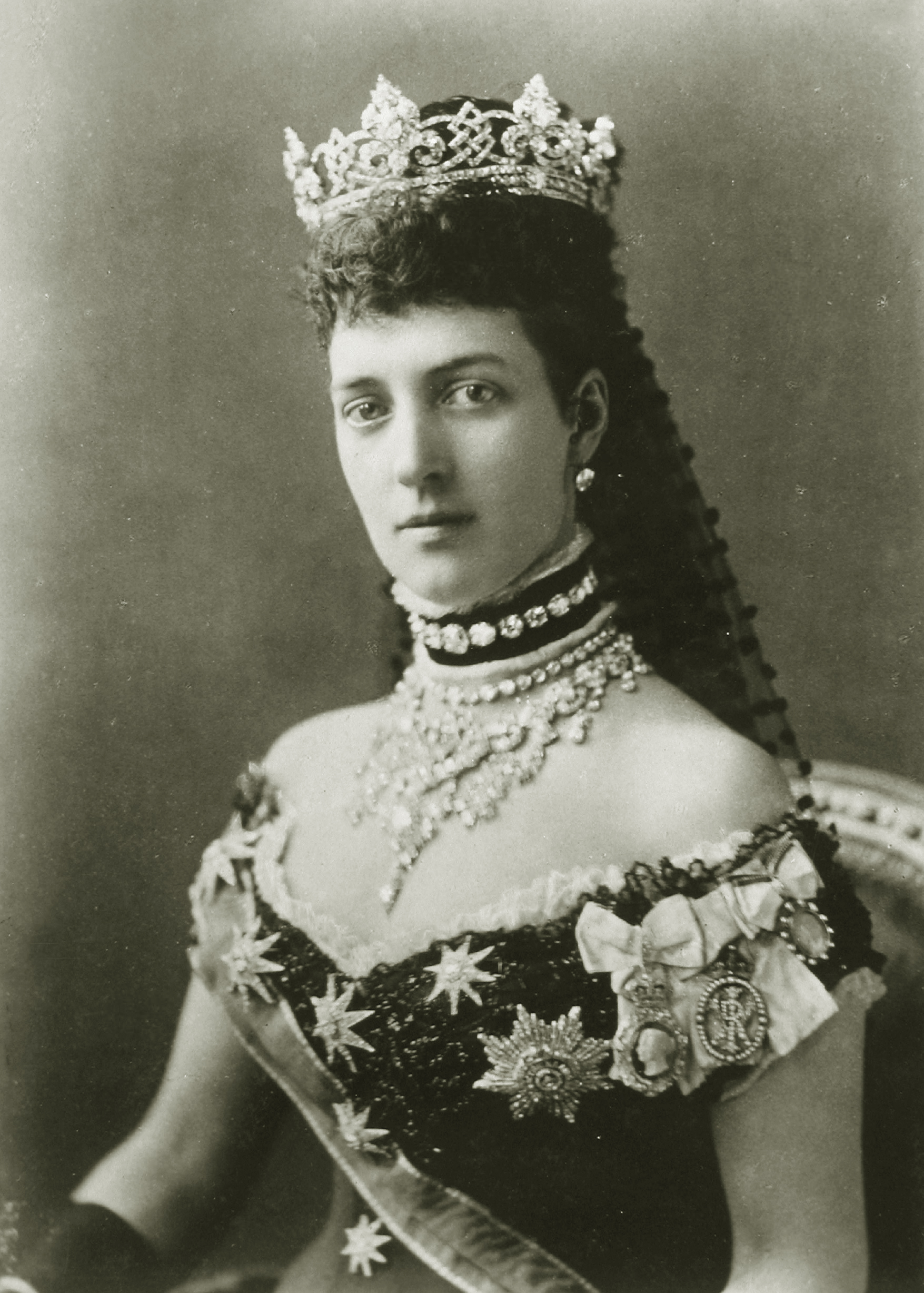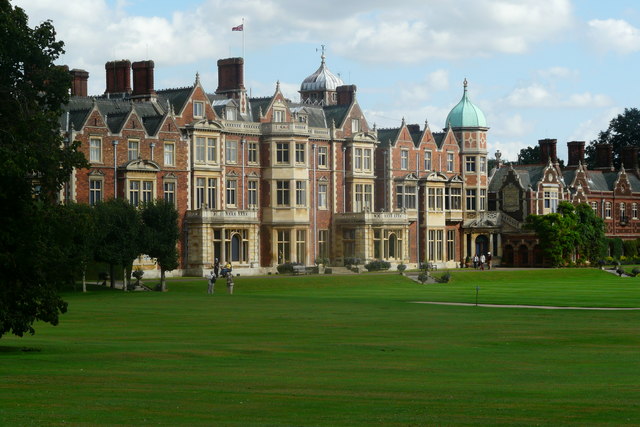by Susan Flantzer © Unofficial Royalty 2014

Alexandra of Denmark, Queen of the United Kingdom; Credit – Wikipedia
Queen Alexandra, the wife of King Edward VII of the United Kingdom, was born Princess Alexandra of Schleswig-Holstein-Sonderburg-Glücksburg (full name Alexandra Caroline Marie Charlotte Louise Julia) on December 1, 1844, at the Yellow Palace in Copenhagen, Denmark. She was the eldest daughter and the second of the six children of Prince Christian of Schleswig-Holstein-Sonderburg-Glücksburg and Princess Louise of Hesse-Kassel and was known in the family as Alix. In 1853, Alix’s father was confirmed as the successor of the childless King Frederik VII of Denmark and she was then Princess Alexandra of Denmark. Upon the death of King Frederik VII of Denmark in 1863, Alix’s father became King Christian IX of Denmark. Three of Alix’s five siblings became a monarch or a consort of a monarch.
- King Frederik VIII of Denmark (1843 – 1912), married Princess Louise of Sweden, had children
- Prince Vilhelm of Denmark, who became King George I of Greece (1845 – 1913), married Grand Duchess Olga Konstantinovna of Russia, had children
- Princess Dagmar of Denmark, Maria Feodorovna after marriage (1847 – 1928), married Alexander III, Emperor of All Russia, had children including Nicholas II, Emperor of All Russia
- Princess Thyra of Denmark (1853 – 1933), married Crown Prince Ernst August of Hanover, 3rd Duke of Cumberland and Teviotdale, had children
- Prince Valdemar of Denmark (1858 – 1939), married Princess Marie of Orléans, had children

King Christian IX of Denmark and his family (Front Row: Dagmar, Valdemar, Queen Louise, Thyra, Alexandra; Back Row: Frederik, King Christian, Vilhelm); Credit – Wikipedia
Queen Victoria of the United Kingdom and her husband Prince Albert were seeking a bride for their eldest son Albert Edward, Prince of Wales, known in the family as Bertie. Victoria and Albert’s eldest daughter Victoria, Princess Royal, Crown Princess of Prussia, known as Vicky in the family, was enlisted to help with the search. Princess Alexandra had originally been fifth on the list of potential brides. Vicky thought Alix would be the perfect match for Bertie and she sent back glowing reports of her to Victoria and Albert. Prince Albert concluded that Alix was “the only one to be chosen. Vicky then arranged the first meeting between Alix and Bertie in Speyer Cathedral on September 24, 1861. On September 9, 1862, after the death of his father in December 1861, Bertie proposed to Alix at the Royal Palace of Laeken, the home of his great-uncle King Leopold I of the Belgians. The couple was married at St. George’s Chapel at Windsor Castle on March 10, 1863. Queen Victoria, in perpetual mourning for Prince Albert, watched the ceremony from Catherine of Aragon’s Closet overlooking the left side of the altar.

Bertie and Alix on their wedding day; Credit – Wikipedia
Within seven years, Alix had given birth to six children. All of Alix’s children were born prematurely. Late in her third pregnancy (with Louise), Alix became ill with rheumatic fever. She safely gave birth without the use of the painkiller chloroform which her doctors thought would worsen her condition. The bout of rheumatic fever continued after the baby’s birth and Alix was in such pain that she had to be constantly comforted by her lady-in-waiting, Lady Macclesfield. The rheumatic fever threatened her life and left her with a permanent limp
- Prince Albert Victor, Duke of Clarence and Avondale (1864 – 1892), unmarried
- King George V (1865 – 1936), married 1893 Princess Mary of Teck; had children
- Princess Louise, Princess Royal (1867 – 1931), married 1889 Alexander Duff, 1st Duke of Fife, had children
- Princess Victoria (1868 – 1935), unmarried
- Princess Maud (1869 – 1938), married 1896 King Haakon VII of Norway, had one son
- Prince Alexander John (born and died 1871), lived one day
As the Prince and Princess of Wales, Bertie and Alix lived at Marlborough House near Buckingham Palace in London and Sandringham House in Norfolk, England. Sandringham House, purchased by Queen Victoria for Bertie and Alix, is still a privately owned residence of the British monarch.

Sandringham House; Credit – Wikipedia
Alix was a popular Princess of Wales and undertook many duties in support of her mother-in-law Queen Victoria, in the words of the Queen, “spare me the strain and fatigue of functions.” Queen Victoria further said of Alix, “She opens bazaars, attends concerts, visits hospitals in my place … she not only never complains, but endeavours to prove that she has enjoyed what to another would be a tiresome duty.” However, Alix’s increasing deafness caused by hereditary otosclerosis led to social isolation and she spent more time at home with her children and pets.
As a mother, Alix was extremely possessive, demanded complete devotion from her children, and insisted that they call her “Motherdear.” Her three daughters were much plainer than their beautiful mother and very shy. Family members referred to them as “the whispering Walses.” Princess Victoria was never allowed to marry as her parents considered all her suitors unsuitable. She was destined to spend her life attending her mother who would ring a bell at all hours of the day and night to summon Victoria to her side. Princess Victoria’s cousin, Grand Duchess Olga Alexandrovna of Russia, described her as little more than “a glorified maid.”
On January 22, 1901, Queen Victoria died and Bertie, at the age of 59, finally became King. The coronation of King Edward VII and Queen Alexandra was held at Westminster Abbey on August 9, 1902. Originally scheduled for June 26, it had to be postponed because the new king developed appendicitis. Bertie and Alix began the idea of the royal family’s public appearances as we now know them during Queen Victoria’s withdrawal after her husband’s death, and they continued this during Bertie’s reign.

Queen Alexandra and King Edward VII on their coronation day; Credit – Wikipedia
During his marriage, Bertie had many mistresses. Alix knew about many of them and accepted them. Among the women, Bertie socialized with were: the actress Lillie Langtry; Lady Randolph Churchill (born Jennie Jerome in the USA, was the mother of Winston Churchill); Daisy Greville, Countess of Warwick; actress Sarah Bernhardt; and Alice Keppel who was his last mistress. Alice Keppel is the great-grandmother of Queen Camilla. When Bertie was on his deathbed, Alix sent for Alice Keppel and arranged for her to see the king during one of his periods of consciousness. When Bertie died on May 6, 1910, Alix quipped, “Now at least I know where he is.”
Toward the end of her life, Alix became almost completely deaf and suffered from mild senile dementia. She died of a heart attack at her beloved Sandringham House on November 20, 1925, just eleven days short of her 81st birthday. She was the longest-lived queen consort since Eleanor of Aquitaine and held that record until the death of Queen Elizabeth The Queen Mother who died at the age of 101. Alix’s remains were brought to London and the cortege proceeded through the streets in a snowstorm. Queen Alexandra was buried with her husband in a tomb on the south side of the sanctuary of St. George’s Chapel at Windsor Castle.
This article is the intellectual property of Unofficial Royalty and is NOT TO BE COPIED, EDITED, OR POSTED IN ANY FORM ON ANOTHER WEBSITE under any circumstances. It is permissible to use a link that directs to Unofficial Royalty.
House of Saxe-Coburg and Gotha Resources at Unofficial Royalty
